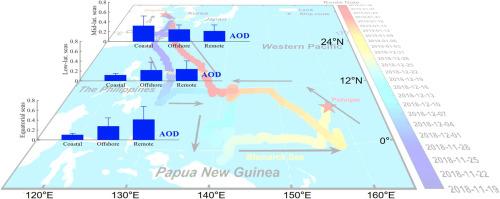科学考察船对西太平洋气溶胶光学特性的自然和人为影响的研究
IF 6.3
2区 环境科学与生态学
Q1 ENVIRONMENTAL SCIENCES
引用次数: 0
摘要
2018年冬季,中国科学院科学考察船在西太平洋进行了气溶胶物理化学实验。本研究系统探讨了自然和人为对海洋气溶胶光学特性的影响,以及多卫星产品和改进方程的适用性。平均气溶胶光学深度(AOD500 nm)为0.31±0.16,Ångström exponent440 ~ 675 nm为0.29±0.30。在中国近海,大量的人为排放影响了海洋环境。在WPO的偏远地区,来自中国北部、西伯利亚、中亚的沙尘气溶胶以及来自北非、阿拉伯半岛和印度西部的对流层上层沉降的沙尘气溶胶占主导地位。在WPO的中纬度和南部海域,AOD的空间变化趋势相反。南亚中纬度海域AOD最高,为0.32±0.23,由近海向远海递减。在低纬度和赤道海域,AOD从沿海向远海显著增加。Ångström指数从沿海到偏远海洋显著下降,因为整个WPO的人为影响减弱。相关分析表明,MODIS-C6和Himawari AOD产品在沿海城市地区具有相似的适用性,而Himawari AOD因其分辨率更精细而被推荐用于沿海背景和海洋环境。在不存在长距离输送的情况下,利用改进算法得到的PM2.5化学成分消光系数与同时测量的AOD呈显著相关(R2 = 0.58),表明改进算法可以较好地代表不受输送影响的海洋气溶胶消光柱状平均值。本文章由计算机程序翻译,如有差异,请以英文原文为准。

Investigation of natural and anthropogenic effects on aerosols optical properties over the Western Pacific ocean by the research vessel KEXUE
In winter 2018, an aerosol physicochemical experiment was conducted in the Western Pacific Ocean (WPO) aboard the Research Vessel KEXUE of Chinese Academy of Sciences. This study systematically investigated both natural and anthropogenic effects on marine aerosols optical properties, as well as the applicability of multi-satellite products and IMPROVE equation. The averaged aerosol optical depth (AOD500 nm) was 0.31 ± 0.16 and Ångström exponent440–675 nm was 0.29 ± 0.30. In offshore China, significant anthropogenic emissions affected the marine environment. In remote WPO, dust aerosols transported from northern China, Siberia, Central Asia, and those settling from the upper troposphere originating from north Africa, Arabian peninsula, and western India, were dominant. The spatial trends of AOD were opposite in the mid-latitude and southern seas of WPO. The highest AOD, 0.32 ± 0.23, appeared along the coast of South Asia at mid-latitude, decreasing from offshore seas to remote oceans. In low-latitude and equatorial seas, AOD significantly increased from coast to remote oceans. Ångström exponent dropped significantly from the coast to remote oceans as anthropogenic influence diminished across the entire WPO. Correlation analysis showed that both MODIS-C6 and Himawari AOD products showed similar applicability in coastal urban areas, while Himawari AOD is highly recommended for coastal background and marine environment due to its finer resolution. The extinction coefficient derived from PM2.5 chemical compositions using IMPROVE algorithm exhibited a significant correlation (R2 = 0.58) with the concurrently measured AOD in the absence of long-distance transport, suggesting that the IMPROVE is a reasonable proxy of the columnar average of marine aerosol extinctions free from transport influences.
求助全文
通过发布文献求助,成功后即可免费获取论文全文。
去求助
来源期刊

Journal of Environmental Sciences-china
环境科学-环境科学
CiteScore
13.70
自引率
0.00%
发文量
6354
审稿时长
2.6 months
期刊介绍:
The Journal of Environmental Sciences is an international journal started in 1989. The journal is devoted to publish original, peer-reviewed research papers on main aspects of environmental sciences, such as environmental chemistry, environmental biology, ecology, geosciences and environmental physics. Appropriate subjects include basic and applied research on atmospheric, terrestrial and aquatic environments, pollution control and abatement technology, conservation of natural resources, environmental health and toxicology. Announcements of international environmental science meetings and other recent information are also included.
 求助内容:
求助内容: 应助结果提醒方式:
应助结果提醒方式:


